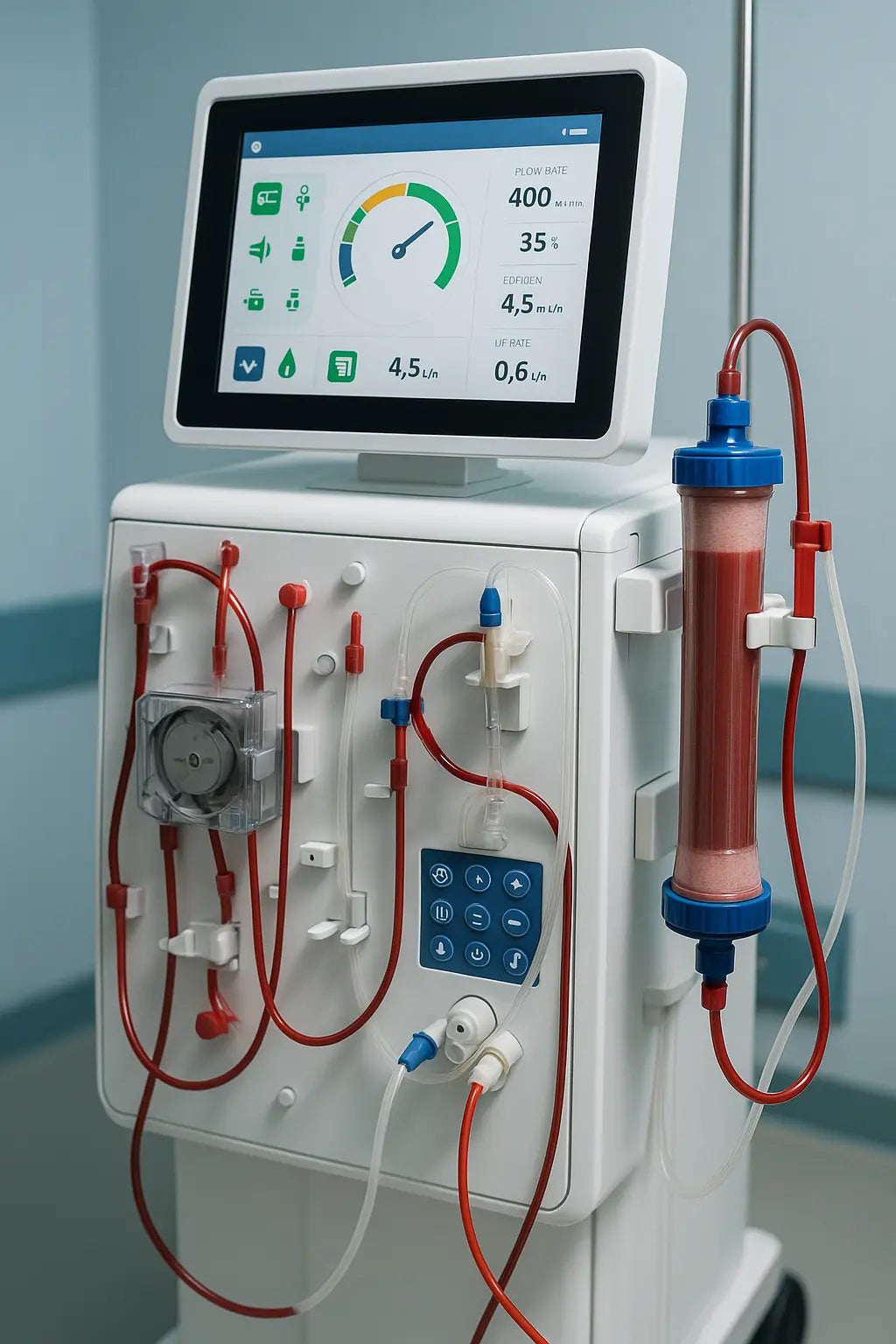Dialysis Machines: A Step-by-Step Guide to the Filtration Process
Dialysis machines play a crucial role in treating kidney failure by filtering waste, excess fluid, and toxins from the blood when the kidneys can no longer perform these functions effectively.
Understanding how these machines work step-by-step helps patients, healthcare providers, and caregivers appreciate the complex filtration process that supports life. This guide will break down each stage involved in dialysis, from blood removal to clean blood return, highlighting key components and mechanisms.

We will also touch on the importance of used dialysis machines—such as those provided by SelfiMed from the NHS—to improve access in low and middle income countries that struggle to afford new devices.
Understanding Dialysis Machines: The Basics

What Is the Purpose of Dialysis Machines?
Dialysis machines are medical devices designed to replicate the kidney’s blood filtration functions in people with kidney failure. They remove waste products like urea and creatinine, excess salts, and surplus fluids while balancing important electrolytes in the blood. This process is vital to maintaining patients' health and preventing life-threatening complications.
Main Components of Dialysis Machines
- Blood tubing: Carries blood from the patient to the machine and back.
- Blood pump: Moves blood through the system at a controlled rate.
- Dialyzer (artificial kidney): The filter where the blood is cleaned.
- Dialysate delivery system: Prepares and supplies the cleansing fluid.
- Monitoring sensors: Check pressures, flow rates, and safety alarms.
- Heparin pump: Administers anticoagulants to prevent blood clotting.

Step 1: Accessing the Patient’s Bloodstream
Preparing the Vascular Access
Before dialysis, a vascular access point is established—usually an arteriovenous fistula (AV fistula), graft, or catheter—providing a reliable entry and exit for blood flow. This step is essential because the dialysis machine must draw blood out and return it safely without causing damage to blood vessels.
Connecting to the Dialysis Machine
The patient is connected via sterile tubing to needles inserted into the access point. Blood flows from the body through the tubing into the dialysis machine, with the blood pump ensuring a steady, appropriate flow to prevent clot formation or damage.
Step 2: Blood Filtration Through the Dialyzer
How the Dialyzer Works
The dialyzer contains thousands of tiny hollow fibers made of a semipermeable membrane. Blood enters the dialyzer inside these fibers, while dialysate—the cleansing fluid—flows around the outside in the opposite direction. This counter-current flow maximizes waste removal.
Diffusion and Ultrafiltration Explained
As blood passes through the fibers, waste molecules like urea and creatinine diffuse across the membrane into the dialysate, while essential elements such as red blood cells and proteins remain in the blood. Ultrafiltration removes excess water by creating a pressure difference that pulls fluid from the bloodstream into the dialysate compartment.
Step 3: Dialysate Preparation and Role
What Is Dialysate?
Dialysate is a carefully formulated fluid that mimics the chemical composition of healthy blood plasma but without waste products. It contains electrolytes like sodium, potassium, calcium, and bicarbonate in concentrations customized to each patient’s needs to help restore chemical balance.
Mixing and Monitoring Dialysate
Dialysis machines mix purified water with concentrate solutions to create fresh dialysate during the treatment. The machine continuously monitors the dialysate’s temperature, pH, and chemical composition to ensure safety and efficacy throughout the session.
Step 4: Returning Clean Blood to the Patient
Blood Flow Back to the Body
After filtration, the cleaned blood flows from the dialyzer back into the patient through a separate tube. The blood pump and monitoring sensors ensure the return flow is smooth and safe, preventing complications such as clotting or air embolism.
Anticoagulation and Safety Features
Heparin is administered via a pump to prevent the blood from clotting within the machine and tubing during treatment. Modern dialysis machines are equipped with multiple sensors and alarms to detect pressure changes, blood leaks, or air bubbles, automatically stopping blood flow to protect the patient.
Step 5: Ultrafiltration and Fluid Balance Management
Removing Excess Fluid
One critical function of dialysis is ultrafiltration—removing excess water that the failing kidneys cannot excrete. The dialysis machine carefully controls the ultrafiltration rate based on the patient's fluid status and prescribed target (“dry weight”). This avoids complications such as low blood pressure or cramps from removing fluid too quickly.
Patient Role in Fluid Management
- Monitoring daily weight to assess fluid gains.
- Following fluid intake limits advised by healthcare providers.
- Communicating symptoms like dizziness or swelling to the care team.
Dialysis Machines and Global Access: The Role of Used Equipment
Challenges in Low and Middle Income Countries
Dialysis machines are expensive and technically complex, making accessibility in resource-limited countries difficult. Many healthcare facilities in those regions cannot afford new machines, limiting patient access to life-saving treatment.
SelfiMed’s Solution with NHS Used Dialysis Machines
Organizations like SelfiMed provide refurbished, reliable dialysis machines from the NHS to low and middle income countries. This approach extends the life of quality equipment, increases access to dialysis treatments, and helps save lives where new tech is prohibitively costly. Ensuring proper maintenance and training remains essential to maximize the benefit.
In summary, dialysis machines perform a sophisticated filtration process involving blood removal, cleansing through the dialyzer, ultrafiltration of excess fluids, and safe return of purified blood to the patient. The step-by-step understanding of this process highlights the technology’s crucial role in managing kidney failure. Additionally, used dialysis machines represent a vital resource for expanding treatment accessibility globally. To learn more about dialysis machines and explore options for supporting kidney care worldwide, visit SelfiMed’s offerings and resources today.

